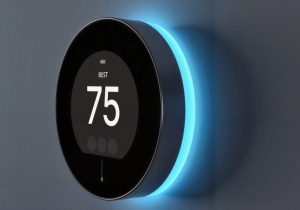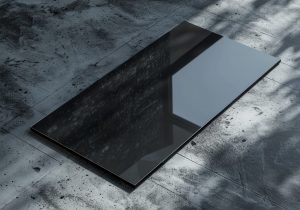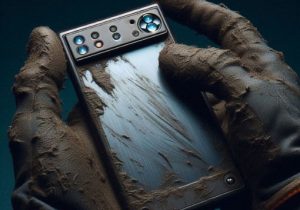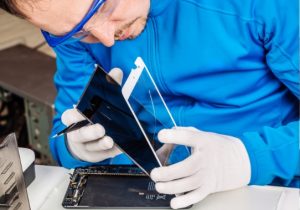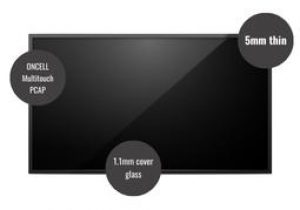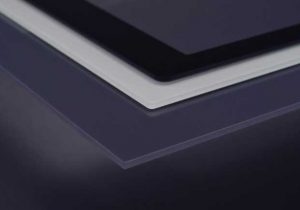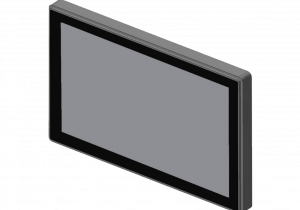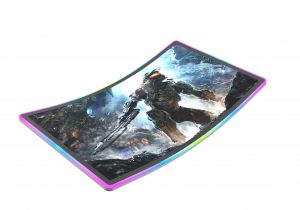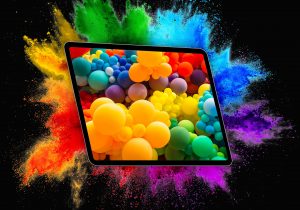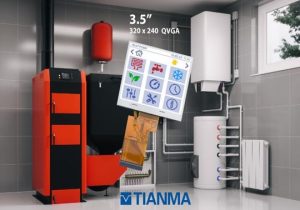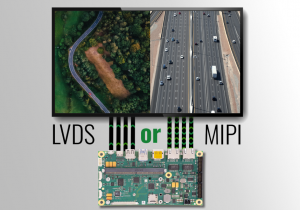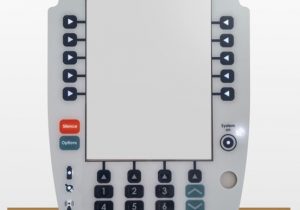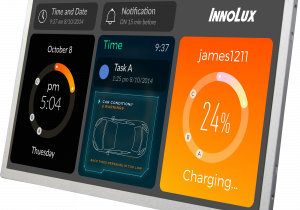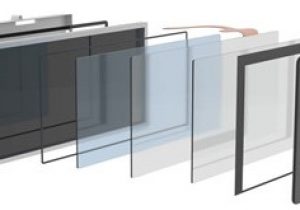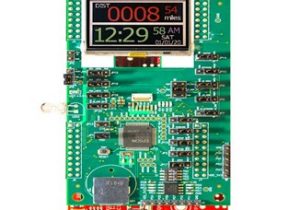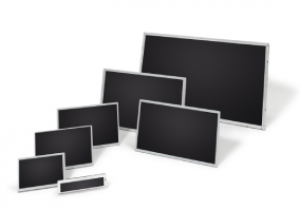Technologies tend to come full circle, but in this case we mean literally – combining an advanced rotary encoder (and encoder shell) with a 1.28-inch circular TFT display for a single, compact control solution. Users can navigate with precision by simply turning or pressing the knob, while the integrated screen displays menus, status updates or graphics right at the point of interaction.
Insights
INSIGHTS
We all know and love e-paper, right? And like they say, if it ain’t broke, don’t fix it. But what if it could be better? What if we could tell you that the latest generation of e-paper from Avnet Displays is smarter, sharper and more sustainable than ever?
As you might imagine, we are very particular when it comes to who we partner with. After all, we have an impeccable track record for giving our customers the very best displays. So, we’d like to introduce you to Silicon Integrated Systems (SiS), whose specialized firmware and hardware meets our every expectation – and yours.
Today, touch displays are a familiar sight in industrial applications, so making sure that they are robust and durable, while also maintaining their brilliance, is essential. This means that we pay particular attention to how each component of the display is connected – a process called ‘optical bonding’.
There are two words guaranteed to make us sigh loudly: cable management. Now, don’t misunderstand us, we know the unique satisfaction of well managed cables, but that feeling is entirely derived from the knowledge that they often need a lot of wrangling.
Are you familiar with Smart Surface Technology? If not, you should be. It’s nothing short of a breakthrough in displays and combines sleek design with the superb functionality that is the hallmark of Avnet Displays.
When devices are designed for use outdoors, there are immediately several challenges to overcome and, for us, one of the most important is getting the balance right when it comes to brightness. But why? Surely, to counteract the effect of strong sunlight we simply use a TFT display with high brightness?
Outdoor environments pose unique challenges for touchscreens - requiring robust construction and exceptional performance under harsh conditions like wet environments, extreme temperatures, vandalism, and electromagnetic interference.
Like most things in life, displays change and improve. As classic displays and control elements are increasingly being replaced by modern display stacks, new processes will come into play to bond the cover glasses or DTCs into their housings.
When it comes to the world of sensor technology, we like to think that we know our stuff. And while the principles that are central to pressure sensors have been around for some time, we’re certainly seeing a new interest in the latest advancements in the field.
It’s not the first time we’ve talked about the phenomena of the ‘ghost touch’ or ‘false touch’, where a touch screen responds, seemingly without human interaction. Fortunately (or unfortunately, depending on how you view it!), there is nothing spooky going on here.
It’s important to take a step back and consider just what your application really needs when it comes to wear and tear. Because while the ultimate in toughness might be your immediate choice, it could be like using a sledgehammer to crack a nut – it’ll do the job, but did you really need all that power?
Capacitive sensors are great – highly reliable and have a wide range of functions. You can’t argue with their usefulness in household electronics, especially as panels in such products are becoming thinner and lighter with almost every iteration. In the automotive world, however, this isn’t exactly desirable. In this industry, sensitive sensor technology is subject to stricter requirements, both in terms of service life and environmental influences.
‘True color’ is one of those expressions that takes on a different meaning, depending on who you’re talking to. For an artist or designer, it refers to the accurate depiction of colour in an image – as close to the original as possible. In the world of displays, it defines the palette of around 16 million colors on a PC (otherwise known as 24-bit color depth).
Are you feeling lost? That you simply don’t have enough hours in the day to spend hunting for the perfect display model? And then there’s the challenge of finding the right partner to help you with your visualization or HMI. Sheesh. It shouldn’t be this hard, right?
Electronic paper (also known as e-ink, electrophoretic display, or electronic ink) is a kind of electronic display that mimics the appearance of ink on paper. An electronic paper display reflects ambient light like paper, unlike conventional flat panel displays that emit light.
See-through TV screens may have been all the rage at this year’s CES in Las Vegas, and we have to admit, we’re fans. But, for us, the excitement lies in all the possible ways this technology can be used in our world of displays.
We don’t need to tell you what exactly is so great about our new 15.6” ONCELL touch monitor – it’s all in the title of this article. But what we do need to explain is how on-cell technology achieves the kind of fast, thin and strong monitor that is ideal for training environments, point of sale and more.
How many times have you touched a glass screen today? Ten? Twenty? Thirty? More? Unless you’re actively monitoring your screen time, it’s barely even a consideration. But the kind of glass you interact with matters. The way it looks influences your experience of the screen, even if you don’t consciously realise it. And the coverglass has usually been designed for the optimum comfort of use – and style.
Sometimes products need a fanfare and sometimes… well, they’re just quietly great. Our new 7” SimplePlus touch display is in the second category. It’s superb – in the right hands. What do we mean by that? Well, on the face of it, it’s what might be called ‘mid-range’. A product that delivers the perfect balance between cost and performance, which is exactly what you need if you’re looking for affordability without cutting corners. You might call it the unsung hero of touch displays.
Made to be integrated, open frame displays have never been more in demand. You’ll spot them everywhere – across Point of Sale, Point of Information, EV charging , Industrial and Marine applications and so many more. It’s a space we’ve been familiar with for some time, offering a wide range of our own open frame solutions for easy deployment in customer applications.
You see a curved touchscreen monitor. You might even be thinking how good it would look in your gaming rig. We see the painstaking mechanical stress needed to form the curve and how to calculate the limits of that stress.
Are you looking for a display that’s high-performance, powerful and prepared for any predicament? We’re always excited to be adding a new range from Tianma to our portfolio, but this one is so good it’s preposterous.
As often happens at Avnet, an acronym is the start of a journey to something pretty cool. Take PDLC, for example. It stands for ‘Polymer Dispersed Liquid Crystals’, which, we must admit, isn’t the catchiest of descriptions. But when you engineer PDLC into glass (or even a self-adhesive film that can be affixed to glass) it becomes much more interesting.
We have it in front of our faces every day, but only pay it any attention if it breaks. A layer of transparent coverglass sits over all the display panels that we use every day – in smartphones and tablets, televisions and monitors – and is essential in guarding the delicate electronics underneath, while also enhancing the quality of the display.
Ultra thin and ultra light, with outstanding optical performance, Active Matrix OLED displays have been a staple technology for smartphones and smaller consumer applications since around 2009. Happily, these small, powerful displays have recently grown in size, opening up opportunities for their use beyond handheld applications.
Our partners at Tianma have just released a thinner, smaller, lower cost QVGA display, ideal for the industrial market, HVAC systems or anywhere that requires a smaller HMI.
Where displays are concerned, plenty of acronyms fly around. MIPI is one, LVDS and RGB/TTL are some others. You’d expect all three to be completely different, but life is never that precise, is it? For example, MIPI displays also use LVDS standards and as puzzling as that might sound, there are actually some fairly sound reasons for it.
Cables. We expect, like us, you have a love/hate relationship with them. On the one hand, for most applications when a TFT is connected to a touch, the complete Stack is connected over a short cable to a board. And that works just fine. After all, for this kind of application, a wireless PCAP makes no sense.
Capacitive sensors are great – highly reliable and have a wide range of functions. But in the medical world there are some very particular requirements around the service life of such sensitive sensor technologies.
We are frequently asked if we can replace old membrane keypads with a new PCAP design. It makes sense, as the membrane design can present many problems – particularly as it ages. Simply put, membrane keys are less durable and their PET foil, which controls responsiveness, can and will break with frequent use.
Plenty of displays need to be able to cope with the varying demands of outdoor use – think EV chargers, construction sites, agricultural vehicles, boats and many more. Displays in these highly variable locations are not only exposed to the elements but feel the full force of heavy duty use every day. As a result, Innolux has launched a new line of high brightness TFT displays that are more than up to the challenge.
Thin, light, cost effective, but with industrial grade reliability and performance, AUO Display+ 15.6” integrated touch solutions are perfect for a range of indoor uses – in-flight entertainment, home automation panels, Point of Sale and kiosk applications.
Industrial standard displays need to perform under all circumstances – in extremes of weather and temperature, or environments where there is a high risk of damage. Traditionally, this has been fulfilled by resistive touch displays, which are essentially two transparent film layers, each with a conductive layer on the inside. To operate, these layers press against each other. However, this continual pressure can be problematic, as it means they lose their resistance over time and eventually wear out. Scratching and a lack of optical clarity is also an issue.
We have seen a huge surge in the use of IoT devices in the last decade or so across various industries. More companies are focused on developing devices that will become part of the connected ecosystem. According to Markets&Markets, the IoT market size is expected to grow from USD 300.3 billion in 2021 to 650.5 billion by 2026. However, with this massive growth comes various challenges and concerns, and one of the biggest challenges has been the power consumption.
As a leading provider of industrial visualization systems, Avnet Displays is implementing complete PCAP glass touch solutions using a new technology to achieve bigger sizes, better optical and EMI performance, along with lower sheet resistance.
Colour TFT (Thin Film Transistor) displays are everywhere. From our beloved phones and wearables to billboards, dashboards, medical equipment and even coffee machines. TFTs are essential to the clear and high-resolution view you expect of any digital display. But as these examples show, the places and spaces in which you might find one vary greatly, and each respective application will have a slightly different operational requirement from its TFT.
Touch-responsive surfaces are as ubiquitous as they are taken for granted but, for us, their sensors are the immediate power behind an effective display solution. We work with companies all over the world, supplying sensors and custom integrating them into display solutions for some of the most challenging industries you can imagine (and some you probably can’t!). So, we wanted to take some time talk about the two main types of touch sensors we offer.
